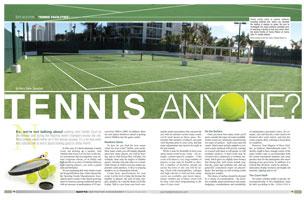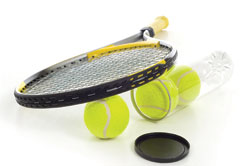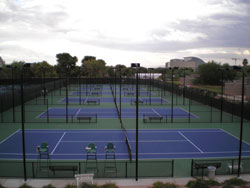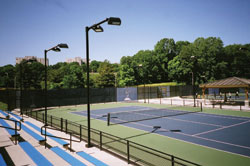
No, we're not talking about walking onto Center Court at Wimbledon and facing the reigning world champion across the net. Most people would rather sit in the stands anyway. It's a lot less work and nobody has to worry about looking good in white shorts.
 In this case, it's about planning a tennis event, not picking up a racquet. And whether that event is as low-key as the tennis tournament that accompanies your annual corporate retreat or as flashy and high-profile as a series of matches between high-ranking players, you want a grand slam performance.
In this case, it's about planning a tennis event, not picking up a racquet. And whether that event is as low-key as the tennis tournament that accompanies your annual corporate retreat or as flashy and high-profile as a series of matches between high-ranking players, you want a grand slam performance.
It's not surprising that more tennis events are being held these days. Data released by the Sporting Goods Manufacturers Association, shows tennis is the fastest growing sport in America among traditional sports with an increase in participation of 43 percent from 2000 to 2008. In addition, there are new player initiatives aimed at getting schoolchildren into the game earlier.
Numbers Game
So how do you find the best tennis venue for your event? Define your needs. How many courts you will require depends upon how many players you will be hosting, and in what format they will play. For example, there may be singles or doubles games, and play may take place in a round-robin format, in which everyone rotates opponents (and partners, if they're playing doubles) or an elimination format.
Create basic specifications for your event. List the level of play, the format, the number of players, the style of play (singles, doubles, etc.) and the hours you'd like to play. Talk to a pro from your local community tennis association who can provide you with an estimate on how many courts you'll need, based on those specs. Remember that numbers of players can (and will) fluctuate prior to your event, and that some adjustments may need to be made at the last minute.
 |
| Photo courtesy of LER, Inc., dba Renner Sports Surfaces, Denver, CO |
While it may be desirable to host your entire tennis event at one venue - for example, a tennis-specific complex - if the event will attract a very large number of players, it may only be feasible to identify a number of facilities spread out across the town or city you will be using. Check with municipalities, colleges and high schools to find out how many courts are available, and (most importantly) whether any of those courts will be busy with other programming at the time of your event.
On the Surface
Once you know how many courts you'll need, consider the types of courts available. Tennis courts are commonly classified into two types of surfaces - hard courts and soft courts. Hard courts include asphalt or concrete courts surfaced with acrylic coatings or covered with sheet or roll goods, or with modular surfaces. A hard court may be covered with a cushioned, or resilient, material, which gives it a slightly more bouncy feel during play. Soft courts include clay, fast-dry, grass and synthetic turf, and are generally considered easier on players' backs, feet and legs, as well as being cooler during hot weather.
 |
| Photo courtesy of Sportsline, Inc., Exton, PA |
The choice of surface should be dictated by a variety of considerations - the facilities available, player preferences and needs, budgetary considerations and availability of maintenance personnel (since, for example, clay and fast-dry courts need to be brushed after each match,and fast-dry courts require daily watering to keep them in condition).
However, notes Tom Magner of DecoTurf, Inc. in Andover, Massachusetts, "A facility ought to have enough courts of the same surface type to accommodate both the actual tournament matches and some practice time for the participants who aren't playing at any given time. In addition, it is critical that all those courts be uniform - same pace-of-play (texture), net height, net tensions, lighting and so on."
The Court Itself
All courts, whether public or private, for recreational play or for competition, must be built according to the rules promulgated by the International Tennis Federation (ITF) in London. The following information is excerpted from The Rules of Tennis, published periodically by the ITF, of which the United States Tennis Association (USTA) is a member:
 |
| Photo courtesy of Fast-Dry Courts, Inc., Pompano Beach, FL |
The court shall be a rectangle, 78 feet (23.77m) long, and for singles matches, 27 feet (8.23m) wide. For doubles matches, the court shall be 36 feet (10.97m) wide. The court shall be divided across the middle by a net suspended by a cord or metal cable which shall pass over or be attached to two net posts at a height of 3-1/2 feet (1.07m). The height of the net shall be 3 feet (0.914m) at the center where it shall be held down tightly by a strap.
Those standard dimensions will be the same whether the court is built in a backyard or at the U.S. Open; however, courts that are built for those higher levels of competition have more space outside the playing area to accommodate line judges, umpires, etc. Make sure the facility you choose complies with all current rules and regulations. A list of governing bodies and informational organizations has been included along with this article.
Whatever type of court is selected, says Bob Deller of Plexipave Div. of California Products, Inc., located in Andover, Massachusetts, an event planner has to think in advance. "Schedule around other tournaments and court repairs such as resurfacing, since some clubs rotate a few courts of resurfacing each year, and others resurface all at once," he notes. In addition, he recommends having an emergency back-up site, such as an indoor arena, in case the weather doesn't cooperate.
Base Model, or Bells and Whistles?
A tennis facility can be equipped with the basics that players need - a court, a net and so on - or it can have some (or many) extras.
 |
| Photo courtesy of General Acrylics, Inc., Phoenix, AZ |
The court fence defines the playing area and keeps balls in play. Beyond that, it can provide an element of privacy to the players if windscreen (the dark-colored mesh fabric hung on the fence) is used. In addition to reducing the impact of wind on play, windscreen also cuts down on distractions, something players - particularly those in a competitive match - appreciate. A 10-foot fence will be suitable to most hard courts where balls tend to bounce higher, while an 8-foot fence will do for a soft court. Fencing can go all around the court, or can be only behind each baseline and partially along the sidelines.
Lighting is actually an issue that straddles the line between a basic need and a luxury touch. A lighting system extends the playing day and makes it possible for a court to accommodate more play. Lighting is necessary for professional matches, with increased levels of light required for higher levels of competition.
Something players will appreciate is a lounge area, or a furnished place to relax between matches, or until their court becomes available. Benches, shade shelters, tables and so forth are examples of these kinds of furnishings. A nearby patio will encourage larger groups to gather to watch play. A drinking fountain, concession stand or soda machine can add to the comfort level. Players will also appreciate lockers or other storage facilities, since most competitive players tend to travel with changes of clothing, multiple racquets and so on. If rest rooms and showers are not located nearby, changing booths can be created for players using special drapes that fit around umpire chairs.
Spectator facilities will be necessary, says Richard Zaino of Zaino Tennis Courts, Inc. in Orange, California. Particularly if your event is intended to draw top-level talent that in turn will attract an audience, look for "seating in abundance - north, south, east and west seating." (A stadium court or one where bleachers can be placed will accommodate the onlookers.)
"If the event is designed to draw players from outside the immediate area, on-site lodging and dining are a real plus," says Randy Futty of Lee Tennis Products in Charlottesville, Virginia. "If on-site accommodations are limited or unavailable, having the proper lodging and dining to fit the visitor demographics close by is a must."
The Competitive Type
As mentioned previously, there is a great deal of variety among tennis events, and these differences will shape a planner's choice of venue. For example, there are "Play for the Cure" weekends, in which tennis players collect sponsorship money and play a set number of hours in order to raise funds for a cause such as cancer research. This type of event, which is recreational in nature, could be played on a large public facility with very little officiating, since fewer "frills" are necessary. However, a tournament or exhibition which draws big-name players may be televised and will have different requirements with regard to lighting, space for cameras and commentators, and so forth. In this case, look for equipment including umpire chairs, scoreboards (manual and electronic versions are available), net tensioning systems to set the net precisely, and electronic line calling systems.
The Setting
Weigh all aspects of the facilities you're considering. These may include:
Parking: Players, spectators, officials, team personnel and others will all want to be close to the facility.
Spectator Conveniences: On-site rest rooms (or portable toilets and hand sanitizing stations) are necessary. Refreshment stands are important too. ADA considerations apply.
Vendor Facilities: Will you have sales or information displays set up by shoe, ball, apparel or racquet manufacturers, or perhaps tennis academies or other vendors? Make sure your venue can accommodate these needs.
Amenities: Public areas should be well-lit. A public address system is necessary, as is a score board and a clock.
Emergency Facilities: If the venue does not have a first-aid tent or office, it must be accessible to emergency personnel.
Media-Friendly: Want newspaper, radio and/or TV coverage? Look for a facility that has a working press box with all the extras - electricity, phones and wi-fi.
Things to Remember
Sports competitions require extensive planning. Don't overlook the basics:
Get it in writing: Find out about permitting, insurance and more for not only the event itself but any ancillary activities such as skill clinics, Cardio Tennis and more. Will transportation be necessary to take players to and from playing sites? Should anything be cleared with the local athletic association, or the state branch of the national governing body?
Officials: If your event will require officials, reserve their time in advance. The local community tennis association or the appropriate section of the USTA can help point you in the right direction.
Keep everyone in the loop: "Communication with potential tournament players and teams is possibly the most important part of a successful tournament," says Randy Futty. "Providing information about the area, directions to the facility, ideas on where to stay and eat, options for entertainment after play is done each day are all important things to get into players' hands early in the process."
Tennis is a fun and challenging game with a rich history and a bright future. Make sure your event contributes to the tradition by serving up an ace.

